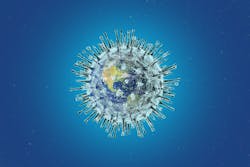COVID-19 studies: Obesity boosts risk; diagnosing health workers
Nearly 36 percent of the first 393 adults admitted to two New York City hospitals with COVID-19 were obese, according to a research letter published late last week in the New England Journal of Medicine.
Also, a research letter in JAMA said that screening healthcare professionals (HCPs) in King County, WA, only for fever, cough, shortness of breath and sore throat might have led their employers to miss 17 percent of those with symptoms of the novel coronavirus, and broadening diagnostic criteria to include muscle pain and chills may still have missed 10 percent.
In the New England Journal of Medicine retrospective case series, the investigators used electronic health record data to describe the clinical characteristics of hospitalized patients admitted from March 5 to March 27 with the novel coronavirus.
Median age was 62.2 years, 60.6 percent were men, and 35.8 percent were obese. "Obesity was common and may be a risk factor for respiratory failure leading to invasive mechanical ventilation," the authors wrote.
The most common symptoms included cough (79.4 percent), fever (77.1 percent), shortness of breath (56.5 percent), muscle pain (23.8 percent), diarrhea (23.7 percent), and nausea and vomiting (19.1 percent). The vast majority of patients (90 percent) had lymphopenia (low levels of lymphocytes, white blood cells important to immunity), while 27 percent had low platelet levels, and many had signs of compromised liver function and inflammation.
Of the 130 patients on invasive mechanical ventilation from March 5 to April 10, only 43 (33.1 percent) have been extubated as of the date the paper was written. Forty patients of the 393 patients (10.2 percent) had died, and 260 (66.2 percent) had been released from the hospital. Complete outcome data were unavailable for the other 93 patients (23.7 percent).
Patients on mechanical ventilation were more often male and obese, with signs of compromised liver function and inflammation. They were also more likely than other patients to require vasopressors (drugs to raise low blood pressure) (95.4 percent vs 1.5 percent), have complications such as atrial arrhythmias (17.7 percent vs 1.9 percent), and require dialysis for the first time (13.3 percent vs 0.4 percent).
Forty patients (30.8 percent) of those on mechanical ventilation did not require supplemental oxygen in the first three hours of arrival at the emergency department.
The researchers noted that the patients' signs and symptoms at admission were similar to those reported in a large case series in China, but that gastrointestinal symptoms were more common in the New York City patients, which could be a reflection of regional variation or a difference in reporting.
The percentage of patients receiving mechanical ventilation was more than 10 times higher than reported in China, which could be attributed to more severe disease and the early-intubation protocol used in New York City hospitals.
The authors said that the high demand for mechanical ventilation and dialysis might surpass their availability during the pandemic. "The observations that the patients who received invasive mechanical ventilation almost universally received vasopressor support and that many also received new renal replacement therapy suggest that there is also a need to strengthen stockpiles and supply chains for these resources," they wrote.
In the JAMA study, researchers interviewed 48 of 50 HCP in whom testing confirmed COVID-19 infection after meeting their facilities' signs and symptoms criteria from February 28 to March 13.
Median age was 43 years (range, 22 to 79), and 37 (77.1 percent) were women. About three-fourths (37) performed direct patient care, and three worked at more than one healthcare facility. Twenty-three (47.9 percent) had underlying conditions.
The most common symptoms at onset included cough (24 [50 percent]), fever (20 [41.7 percent]), and muscle pain (17 [35.4 percent]). Eight HCPs initially reported no fever, cough, shortness of breath, or sore throat but did have chills, muscle pain, inflammation of the nasal mucus membranes, and general discomfort. One person reported only inflammation of the nasal mucus membranes and headache.
Median time from illness onset to symptoms was two days (range, one to 7). When muscle pain and chills were included in the criteria at illness onset, case detection increased from 40 (83.3 percent) to 43 (89.6 percent). Thirty-one HCPs worked a median of two days (range, one to 10 days) after symptom onset.
The authors said that expanding symptom-based screening criteria, testing and furloughing symptomatic HCPs, and creating nonpunitive, flexible sick leave policies consistent with public health guidance are good options to prevent transmission from HCP.
"Face mask use by all HCP for source control might prevent transmission from mildly symptomatic and asymptomatic HCP," they wrote. "This may be particularly important in long-term care facility settings and regions with widespread community transmission."

